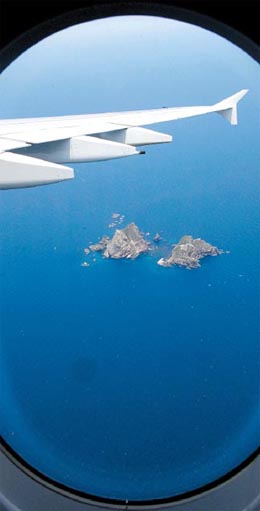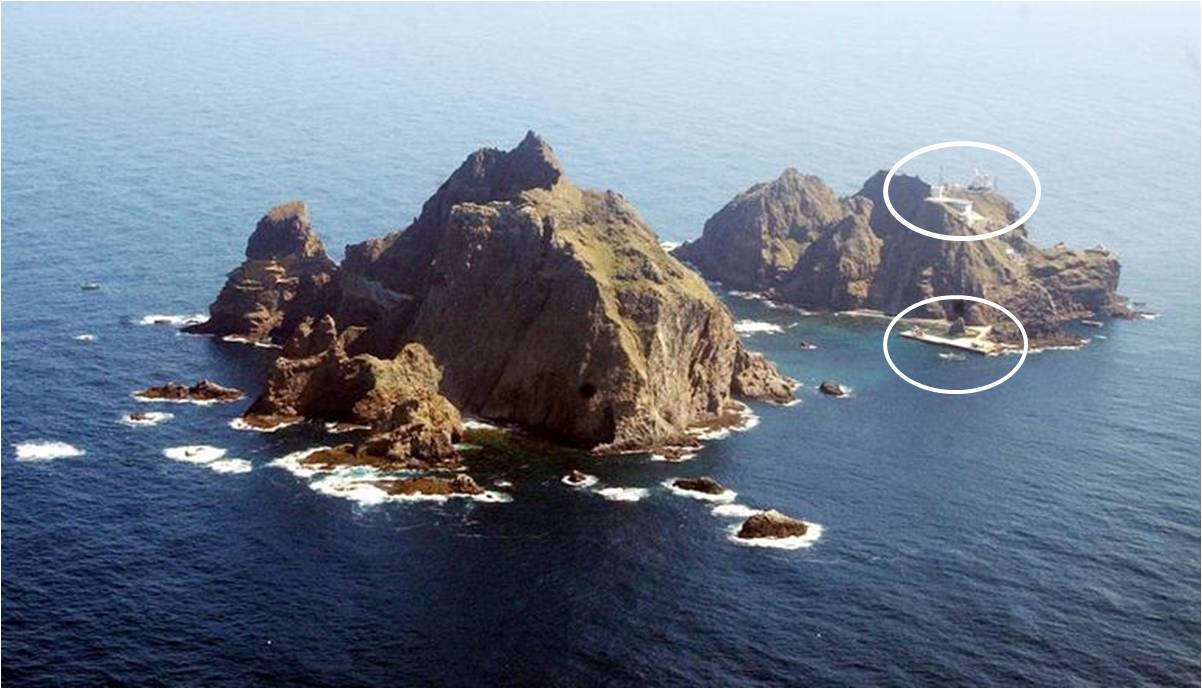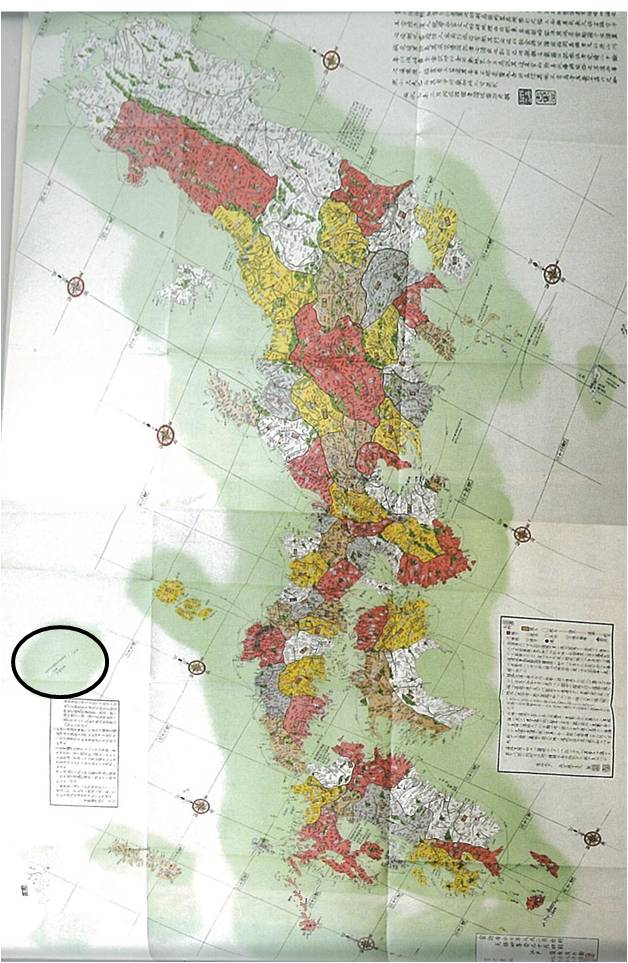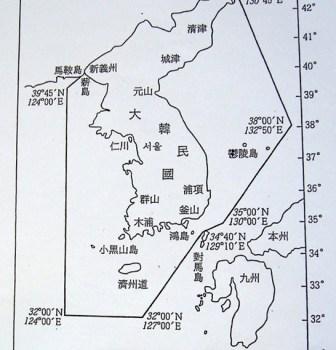By John M. Rodgers
Some 215 kilometers or 133.6 miles off the eastern coast of the Korean peninsula sits an isolated cluster of rocks that were formed several million years ago by lava from underwater volcanic eruptions. Among the 35 islets stand two larger ones, Suhdo (the West islet) a sharp-sided rock nearly 100 meters high and Dongdo (the East islet) 174 meters high, which make up Dokdo (meaning “lonely island” in Chinese characters though some say the translation in Korean can mean “rocky island” as “dok” can mean “dol” (rock) in a different Korean dialect). Lonely or not, Dokdo has been at the center of a territorial dispute with Japan for more than a century with the last decade providing some of the most heated strife due to the Japanese government’s insistence that the island is theirs and the inclusion of this assertion as fact in school textbooks.
Scholars say that the earliest mention of these islets stretches back to 512 A.D. during the Silla Kingdom when they comprised the island state of Usanguk which included the larger island of Ulleungdo 87 kilometers west of Dokdo. Japanese maps from the 17th and 18th centuries appear to clearly mark both Dokdo and Ulleungdo as part of Korean territory. Japanese government documents from 1695-96 show that Japanese citizens were prohibited from sailing to the area after officials from the closest Japanese province to the islets reported to the Tokyo government that the land was not part of its territory. Again in 1870, the central government ordered an inquiry into the islets and came up with the same conclusion. Then in 1877 the Daijō-kan (the department of state and highest authority during the Meiji period) gave instructions that the islands had “nothing to do with Japan.”
At the beginning of the 20th century, the Korean government announced Imperial Ordinance No. 41, thereby establishing the county of Ulleung (Ulleung-gun) which included Dokdo—essentially this was the same as Usanguk though Usanguk was actually considered its own country during the Silla Kingdom. Japan, which had called the islands Matsushima or Ryanko in the past, eventually settled on Takeshima or “bamboo island” somewhere around 1904, the year that they began the process to annex the peninsula. Official documents show that in February of 1904 Japan sent troops to Seoul to convince the government to sign over effective control of government operations. So began the process by which the Protectorate Treaty was completed in November of 1905 and the entire peninsula was annexed in 1910 under the Japan-Korea Annexation Treaty. The 1904 action by Tokyo came at the start of the Russo-Japanese War and was seen, in part, as a move to gain control of territory that could be utilized as a “base to watch the movement of every naval ship,” according to one member of the Japanese Foreign Ministry. These facts are not denied by the Japanese government.
In fact, when a group from Japan’s Shimane Prefectural Office visited Ulleung-gun’s governor in March of 1906 to remind him that Dokdo was part of Japanese territory, he reported to his superior—the governor of Gangwon province (Gangwon-do)—that Dokdo belonged to his county.
Japan’s colonization of Korea speaks for itself. Once Japan was defeated in World War II, Korea was liberated and the U.S. military stayed behind in Japan to facilitate war reparations, to draft a pacifist constitution and to deal with territorial issues among other things. General Douglas MacArthur, Supreme Commander of the Allied Powers (SCAP), first decreed that Dokdo, Ulleungdo and Jejudo were no longer under Japanese control. In 1947, the Japanese adjured the SCAP to grant them sovereignty over Ulleungdo and Dokdo and were promptly refused. The land was Korean territory, the SCAP reiterated.
Yet in 1951, Korea found itself in the middle of a political game during the Treaty of San Francisco which resolved war related issues, officially bringing an end to World War II. Because 48 countries were involved in the negotiations, innumerous drafts were drawn up. Regarding the issue of Dokdo, it was initially listed as Korean territory but in later drafts came up as Japanese territory and, finally, was omitted from the treaty. Ulleungdo and Jejudo were officially declared Korean territory in the treaty. Some say the fact that the Korean War was underway led negotiators to throw up their collective hands on the issue. Others mention William Sebald who was the U.S. Department of State’s political adviser in Japan, foreign affairs director for the Allied Forces Supreme Commander and representative of the United States to the Allied Forces’ Board of Directors in Japan. Sebald had deep ties in Japan having moved there in his 20s and later marrying a second-generation English-Japanese woman whose mother was a Japanese painter while her father was an English lawyer running a law firm in Japan (Sebald later took over that firm). Reports assert that Sebald was connected to the Japanese elite—including the imperial family—and lobbied to have Dokdo listed as Japanese territory in the Treaty. Many point to Sebald’s entrance into negotiations as the time when the drafters reversed the Dokdo declaration. Reportedly the United Kingdom and Australia refused the claim and the standoff led to no mention of Dokdo in the final draft.
Following the signing of the Treaty in 1951, South Korea did not sit idle. President Syngman Rhee, already in the middle of the Korean War, declared the “Rhee Line” or “Peace Line” on January 18, 1952, essentially establishing a boundary to protect Korean marine resources in the East Sea including around Dokdo and Ulluengdo. However, because it was during the Korean War, Rhee couldn’t spare military assets to enforce the law. As a result, civilian groups from Ulleungdo travelled out to the islands where they fended of Japanese citizens attempting to occupy the island. Following the Korean War, Rhee dispatched naval vessels and weapons to the area where they aggressively apprehended trespassers. In addition, the Korean government built police facilities and a lighthouse on Dokdo. Since 1954 Korea has had Korean people living on the island including a police detachment.
The 1965 Treaty of Basic Relations between Japan and South Korea more than ten years later was the first real step towards officially normalizing relations between the two countries. Nonetheless, Dokdo remained a central obstacle during negotiations and was not resolved in the Treaty.
Since that time protests have been fomented by Japanese actions or claims to the island. Largely, the Japanese populous seems uninterested in the issue—the government and some fringe groups are the main voices that one will hear celebrating Takeshima Day. In Korea the issue is an open, festering sore which the Japanese, every so often, rub salt on by announcing a new text book, the aforementioned Takeshima Day or sending out a flotilla to do a hydrological survey of the islets.
According to recent reports, the next step for South Korea following Japan’s March 30 announcement of more text books will be one of less quiet diplomacy and more action. A plan to dispatch some 20 new frigates to the area around Ulleungdo and Dokdo was announced by the government. Additionally, Seoul plans to rebuild the 30-year-old heliport on the island while also building a marine science research facility in the waters around the islets.
 Over the summer more sparks flew after a Korea Airlines flight flew directly over the islets during an Airbus A380 test flight. The Japanese government responded by banning all officials from flying with KAL and officially visited KAL’s headquarters in Seoul to lodge a protest.
Over the summer more sparks flew after a Korea Airlines flight flew directly over the islets during an Airbus A380 test flight. The Japanese government responded by banning all officials from flying with KAL and officially visited KAL’s headquarters in Seoul to lodge a protest.
Then in late July, several Japanese lawmakers announced a visit to Ulleungdo where they intended to refute the sovereignty of Dokdo. Public reaction in Korea was swift and calls for a ban on the visit spread far and wide with the Korean government eventually prohibiting entrance to the country. Yoshitaka Shindo, and two other members of the Liberal Democratic Party arrived on August 1 slightly before noon at Gimpo airport where they were refused entry. Reportedly the three protested and argued with immigration officials until they were given the option of boarding an 8:10 p.m. flight back to Japan or heading off to be processed as illegal immigrants. They chose the latter. Two weeks later Grand National Party chairman, Hong Joon-pyo, stated that marines should be posted on the island adding that “now is the time when we must confirm our will to defend our land on Dokdo.” Whether or not marines are posted on the island, it is clear that further provocations should be expected.
Note: There is a print link embedded within this post, please visit this post to print it. ![]()
![]()
![]()
![]()
![]()
![]()
![]()
![]()
![]()
![]()
![]()
![]() Other Sharing Services...
Other Sharing Services...
| Thethreewisemonkeys.com 3WM Social Media    |
|
'Hood News Art Event/PSA Expat Life Featured Fiction/Poetry
From the Scene Korean Life Politics Rant Review Student Writing Travel








Recent comments